Visit Pridnestrovie (Transnistria): What to see in Tiraspol and Bendery in the unrecognised state of the Pridnestrovian Moldavian Republic
We’ve been twice to Pridnestrovie (Transnistria), a de facto/non-recognised country/state that split away from Moldova after the dissolution of the USSR in the early 1990s. On our first visit, we travelled from Chisinau in Moldova to Tiraspol, the capital of Pridnestrovie (Transnistria), spent the night there and then took a bus the following morning to Odesa in Ukraine. In all honesty, after a few hours of wandering around Tiraspol, we were bored and spent the rest of the afternoon down on the Dniester River, which was what most of the locals were doing given it was such a hot day.
That was three years ago in June 2016, and since then we’ve more or less written Pridnestrovie (Transnistria) off as a destination we would probably never return to. We didn’t feel bad about it either as most other people we’ve met or spoken to about their time there (basically Tiraspol as that’s where most people go) expressed the same sentiment.
With the nucleus of the trip being our interest in Soviet/socialist-era architecture and monuments, we decided to spend a large part of the summer of 2019 in Romania, Bulgaria and Moldova. These days, our research before heading out on the road is pretty intense. I spend a lot of time identifying places of interest and Kirsty expends an equal amount of energy locating them on a map. Our fact-finding for all three countries paid off and during our seven weeks in the region, we found some incredible sights to marvel at and photograph (none of which we have written about yet!). As the trip progressed, Pridnestrovie (Transnistria) started to bug us. We don’t like giving up on a place and if we could find so much related to our specific genre in the neighbouring countries (we spent a whole week looking around Chisinau, for example, and still didn’t see everything on our list), why was it that after a couple of hours we’d run out of things to do in Pridnestrovie (Transnistria), a breakaway socialist republic that still features the hammer and sickle in its coat of arms?
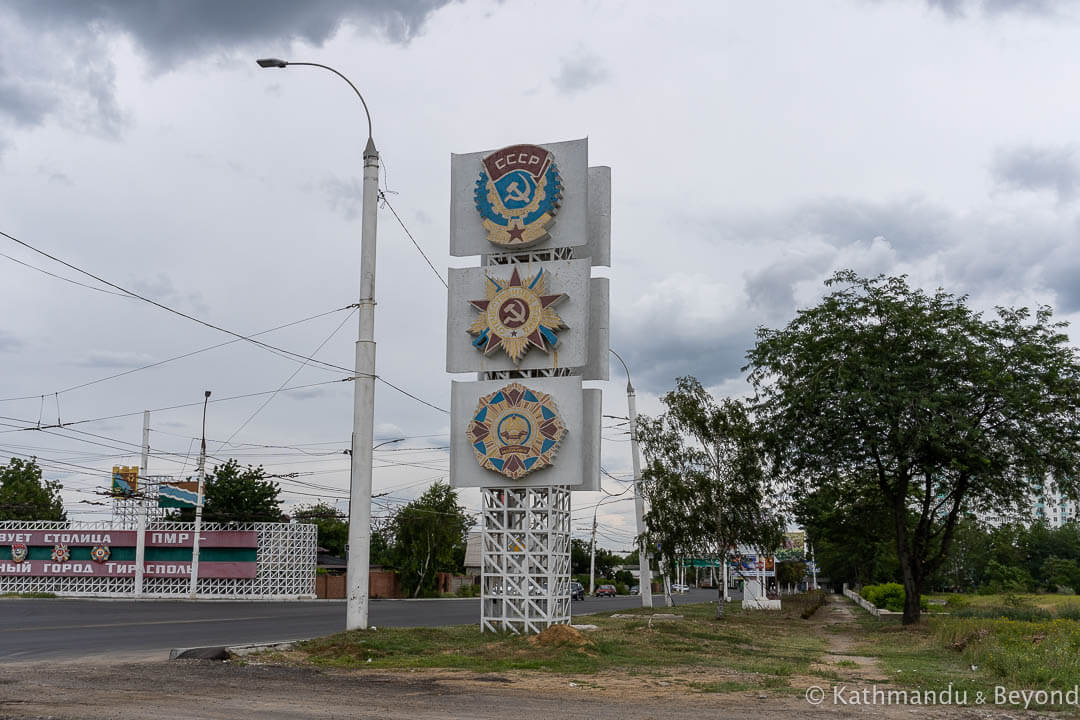
Monument to the 40th Anniversary of the Victory over Nazi Germany (Tiraspol Awards Monument)
We started to delve once more and further investigation, along with first-hand recommendations (and most importantly coordinates!) from two friends (thank you Heather and Kami!) who had recently been in Pridnestrovie (Transnistria) and who we met with in Chisinau, meant that we had enough to warrant a second visit as part of the above trip.
If you are visiting Pridnestrovie (Transnistria) as a day trip from Moldova, you will be issued with a 10-hour visa at the border checkpoint – see later (*). We managed to cram a lot into our allotted 10 hours and came away exhausted but very satisfied with what we had seen. A lot of this had to do with visiting Bendery (Bender), Pridnestrovie’s (Transnistria) second city, for the first time. For us, it was more interesting than Tiraspol and combining the two cities on the same visit was a great idea and, apart from one hiccup (see below), fitted perfectly into the time we had.
(*) You can stay up to 45 days in Pridnestrovie (Transnistria) but you need to have accommodation booked/provide an address of where you are going to stay for the period of time you intend to remain there.
As a result of our second visit to Pridnestrovie (Transnistria) in July 2019, our attitude to towards the de facto state is now changed completely.
How best to utilise a 10-hour visa in Pridnestrovie (Transnistria)
Using foot-power and the local bus to get from Tiraspol to Bendery, here is our Soviet-inspired suggested itinerary for the best way to spend 10 hours in Pridnestrovie (Transnistria) on a day trip from Chisinau…
The marshrutka (fixed route minivan) from Chisinau will drop you off outside the train station in Tiraspol. Most places of interest in the city are on, or just off, 25th October Street. A good place to start is Pobedy (Victory) Park, which is at the eastern end of the street. Here, you will find an antiquated, but still operational, funfair and plenty of Soviet-era statues. Note, just after leaving the railway station, on the left-hand side of the road, there is a faded outline of Lenin’s head on the side of the building.
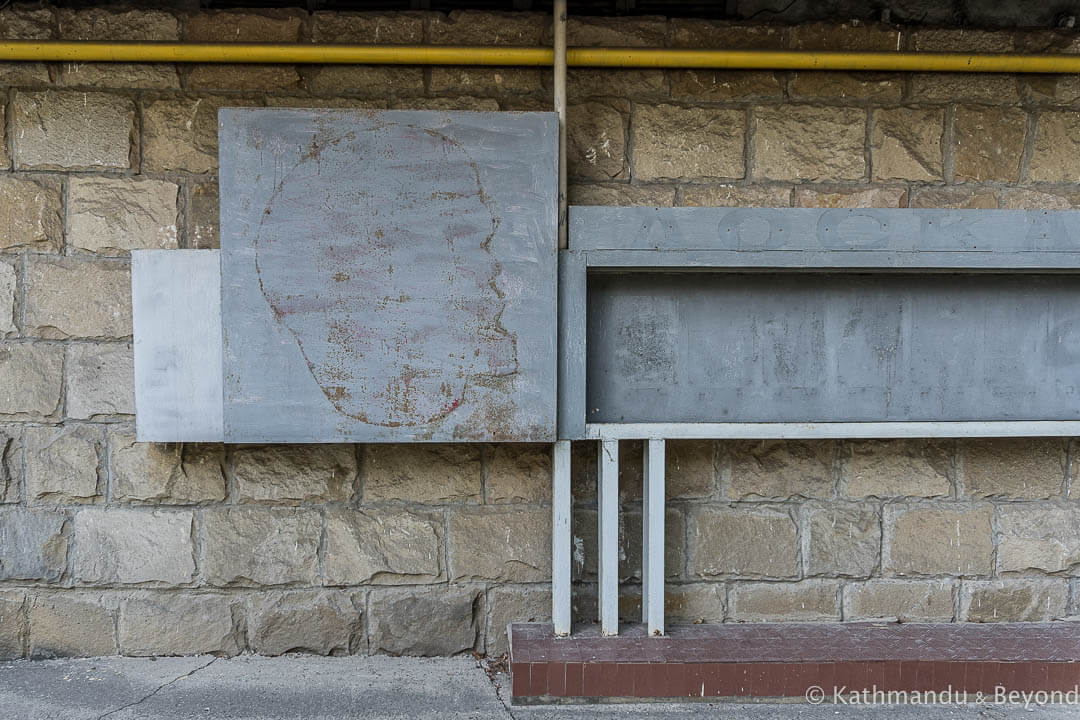
Outline of Lenin’s head on the side of the building in Tiraspol
After visiting Pobedy Park, walk in a westerly direction along 25th October Street. Next up is the Drama and Comedy Theatre and then a monument to Taras Shevchenko, the Ukrainian artistic polymath who laid the foundations of modern Ukrainian literature and language. More striking, however, is the Memorial to Students and Teachers who died in the Great Patriotic War, which is opposite the Shevchenko monument and in the grounds of the Transdniestrian State University. You’ll then see the Monument to Yuri Gagarin, the famous Soviet cosmonaut, before coming across the Stalinist Empire style House of Soviets/City Hall which has a large bust of Lenin outside it.
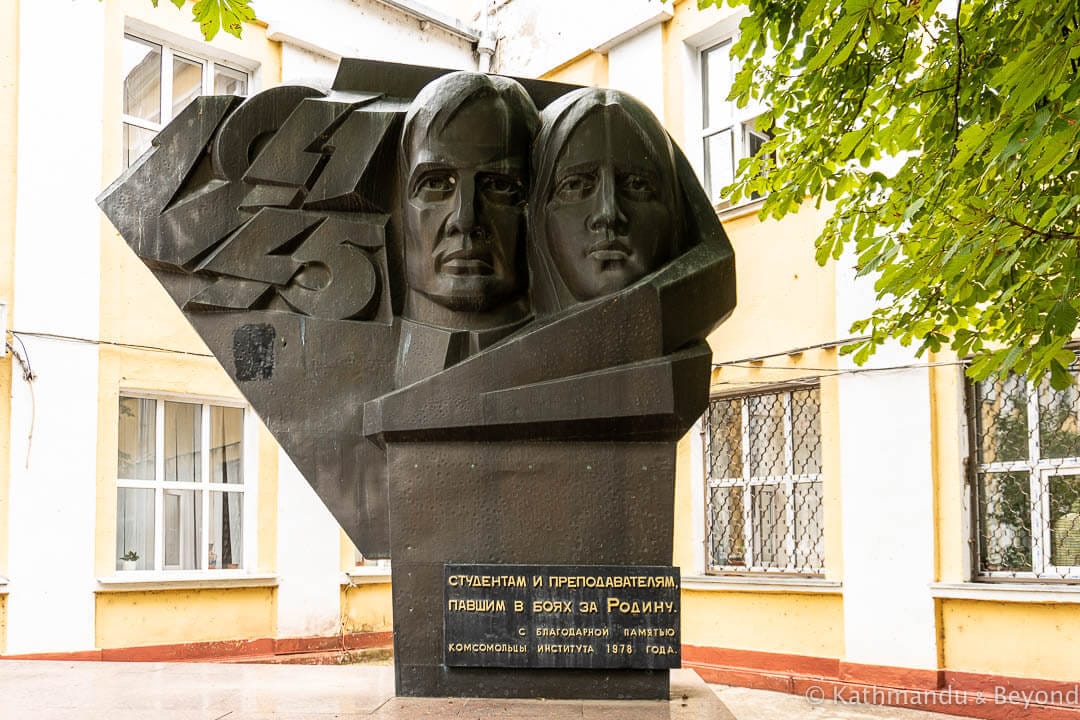
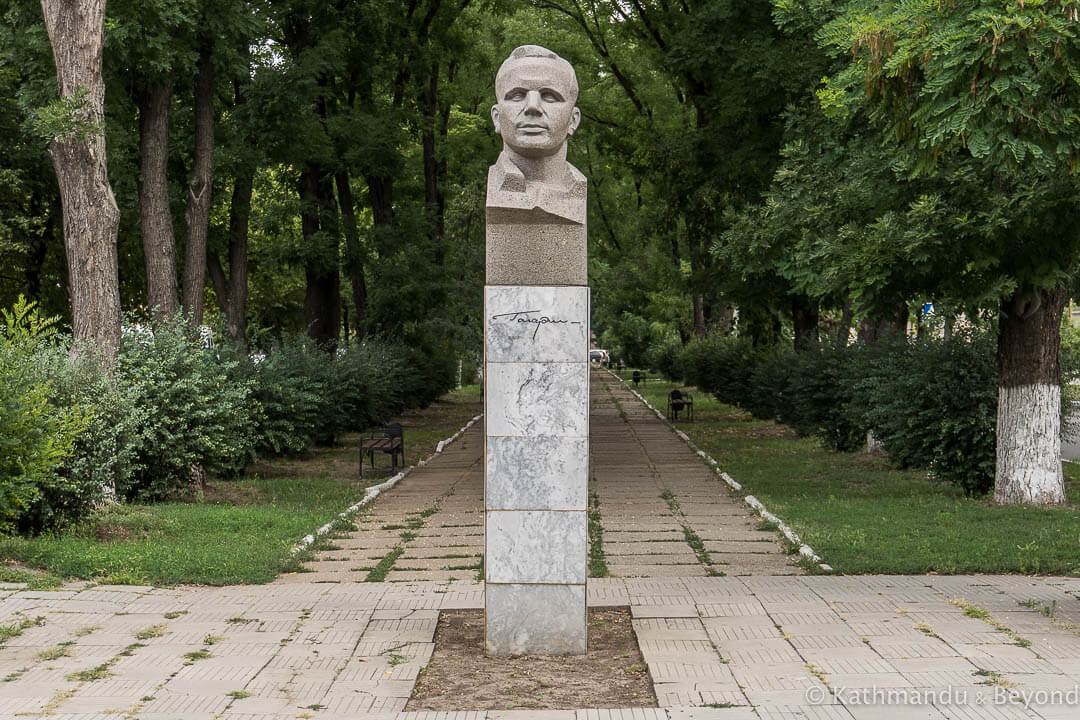
Tiraspol: Memorial to Students and Teachers who died in the Great Patriotic War (left) and Monument to Yuri Gagarin (right)
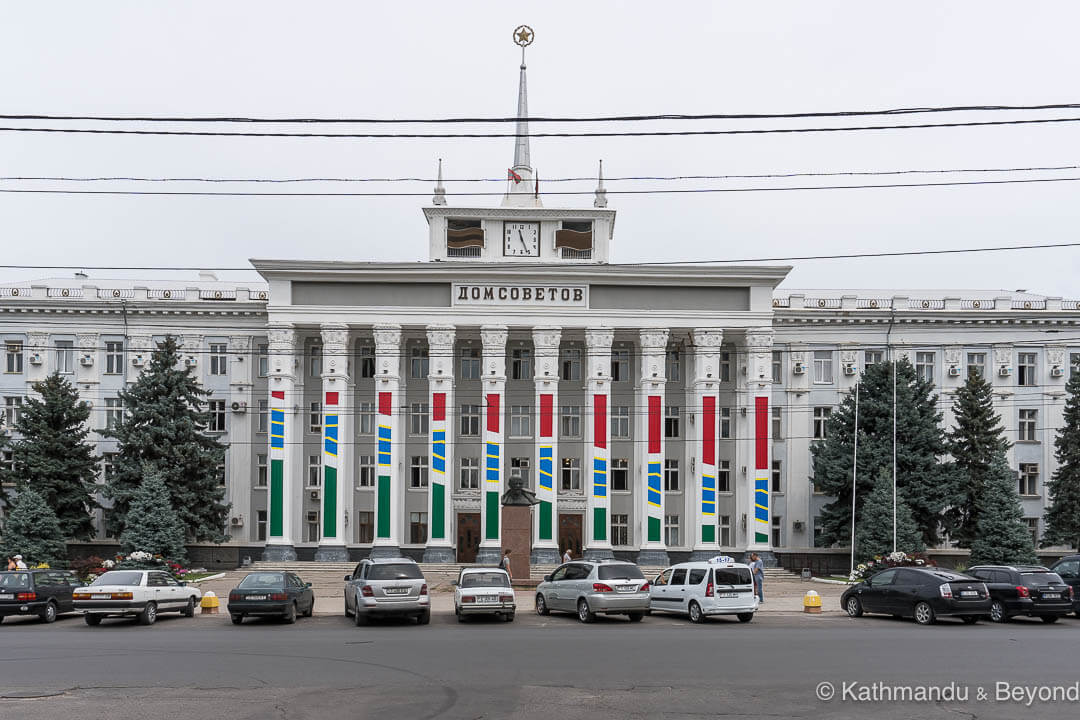
House of Soviets/City Hall, Tiraspol
As an aside, 25th October Street is a strange thoroughfare. There isn’t much traffic or people on either the road or the pavements which gives it an air of calmness. This is especially true if you’ve just come from Chisinau and the walk along its length is a pleasant, if rather bemusing, experience.
If you want to stop for something to eat or drink, 7 Fridays Cafe is not far away, on the left-hand side of the road. Otherwise, the next place of interest is the Palace of the Republic, which has some interesting Soviet-era bas relief on the front of the building. At the junction of 25th October Street and Shevchenko Street, there are two more nice murals on each end of the building to the left and over the road is the modernist Cinematograful Tiraspol (Cinema Tiras) and the House of Culture, just behind it. Suvorov Square is the main square in the city and is marked with a large sculpture of Alexander Suvorov, the founder of Tiraspol, on a horse. We were more taken with the chunky Palace of Children and Youth Creativity, which is also on Suvorov Square and if you are keen to see a church or two, the Church of the Nativity is also nearby.
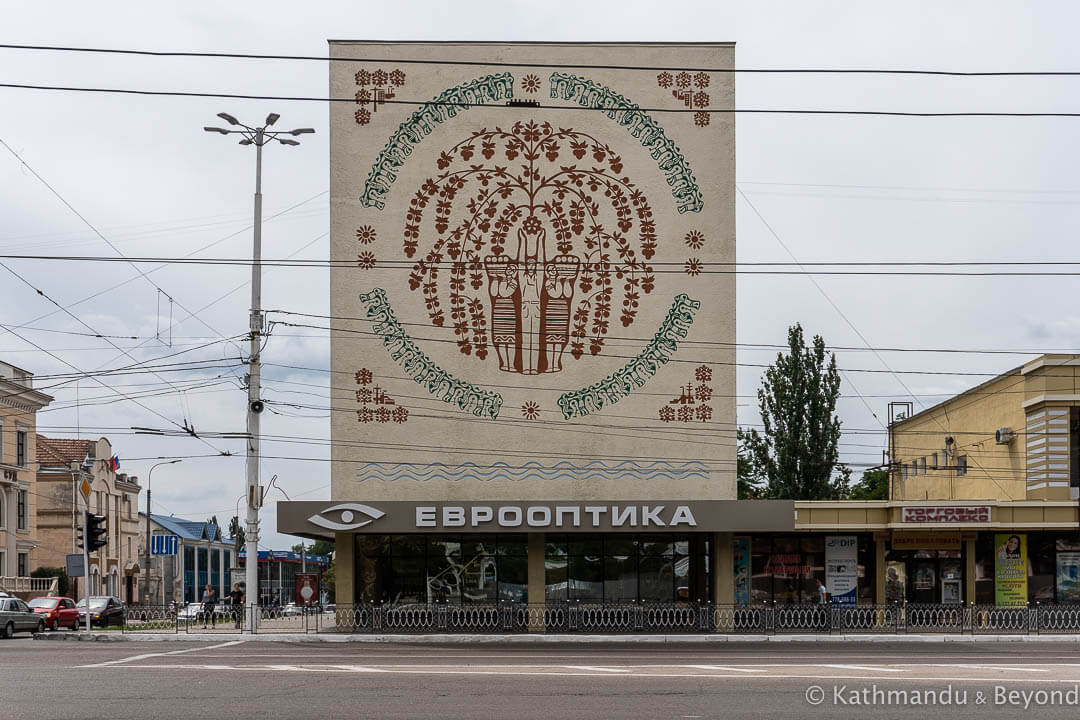
The junction of 25th October Street and Shevchenko Street, Tiraspol
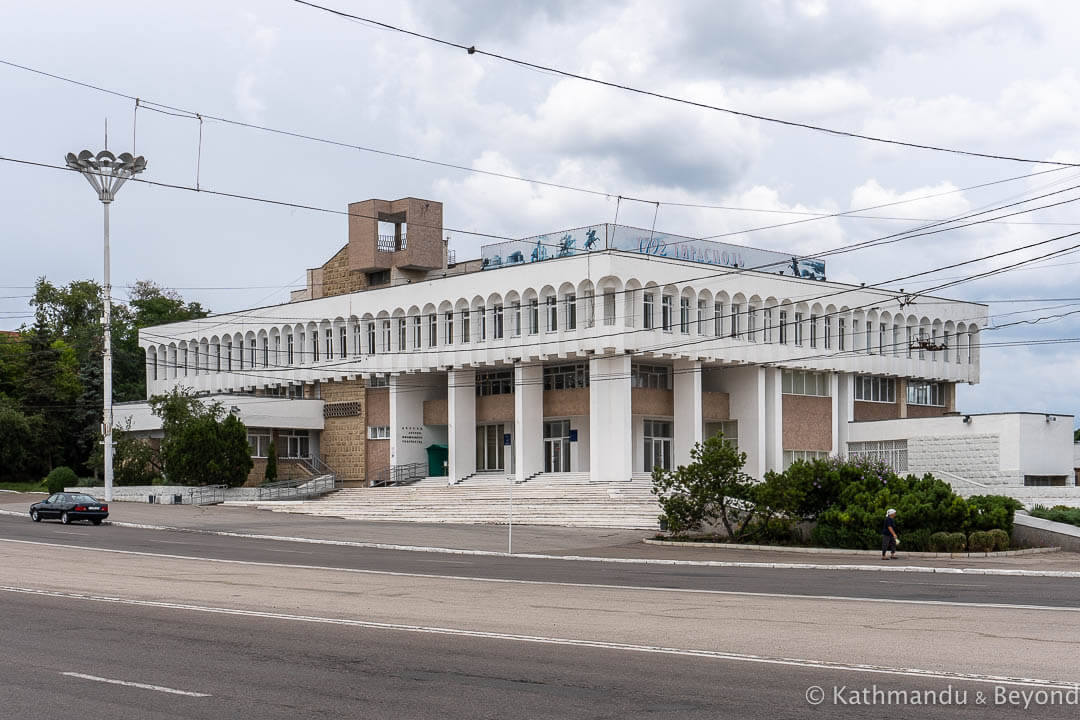
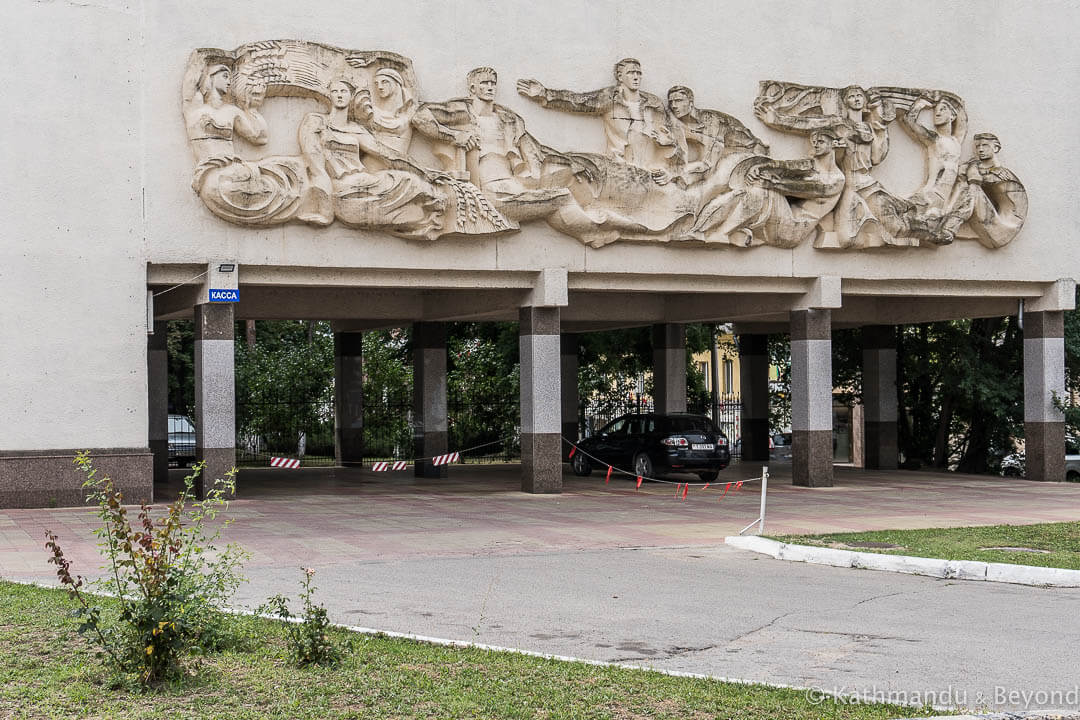
Tiraspol: Palace of Children and Youth Creativity (left) and Palace of the Republic (right)
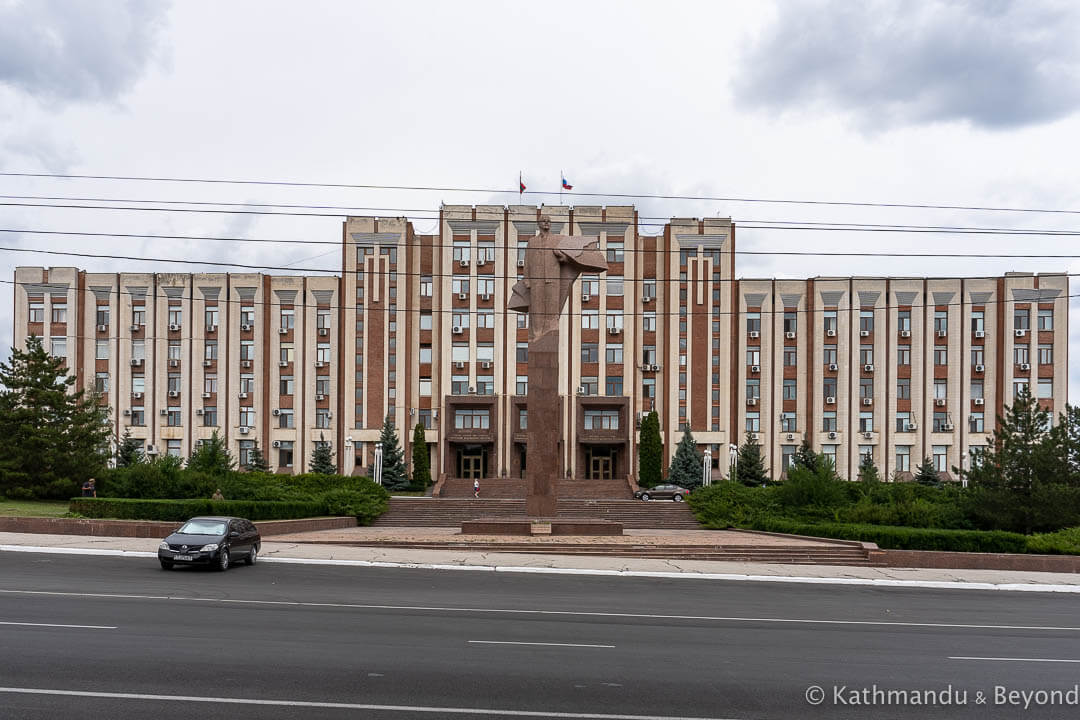
Transnistria Parliament, Tiraspol
Before spending time at the Memorial Complex of Glory, we would recommend heading south and taking a look at the Dniester River. You can do so either from the bridge that crosses it or by making your way down to the nearby beach. After seeing the Memorial Complex of Glory, keep walking along 25th October Street the short distance to the Supreme Council of the Pridnestrovian Moldavian Republic (Transnistria Parliament) building, which is guarded by a formidable statue of Vladimir Lenin.
This is normally the point where visitors call it a day. It was the same for us when we first went to the city and that’s why our impressions of Pridnestrovie (Transnistria) afterwards were mediocre at best. But, if you keep walking along 25th October Street until you hit the intersection with the main road that links Tiraspol with Bendery you’ll not only see another couple of interesting monuments but also be able to easily board a bus heading for Bendery and have a look around there as well.
About 600 metres west of the parliament building is the Monument to the First Moldovan Power Plant and just a few metres along from there, on the same side of the street, is the small Monument to those killed during the Fascist Occupation. Finally, at the end of 25th October Street is the much larger Monument to the Liberators of the City.
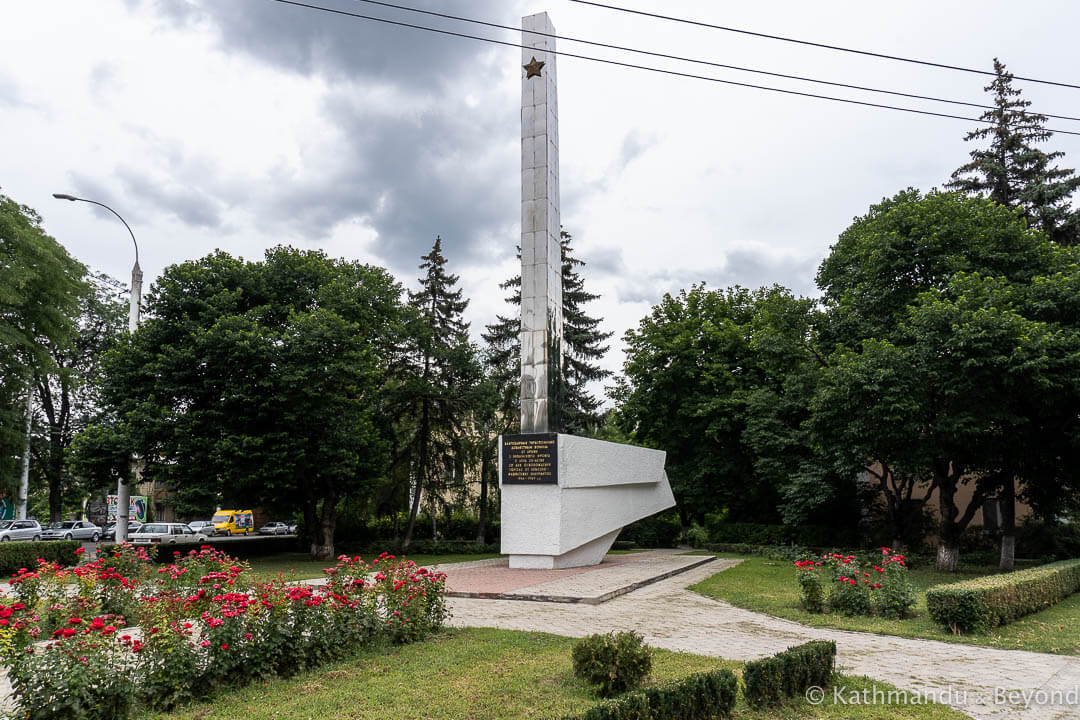
Monument to the Liberators of the City, Tiraspol
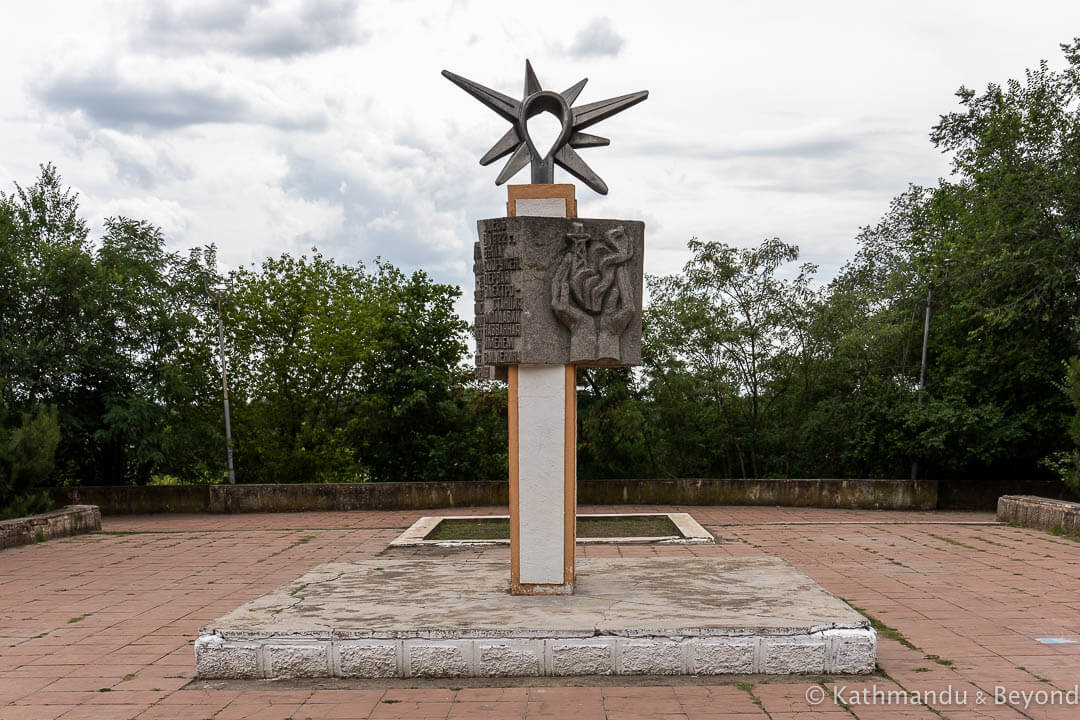
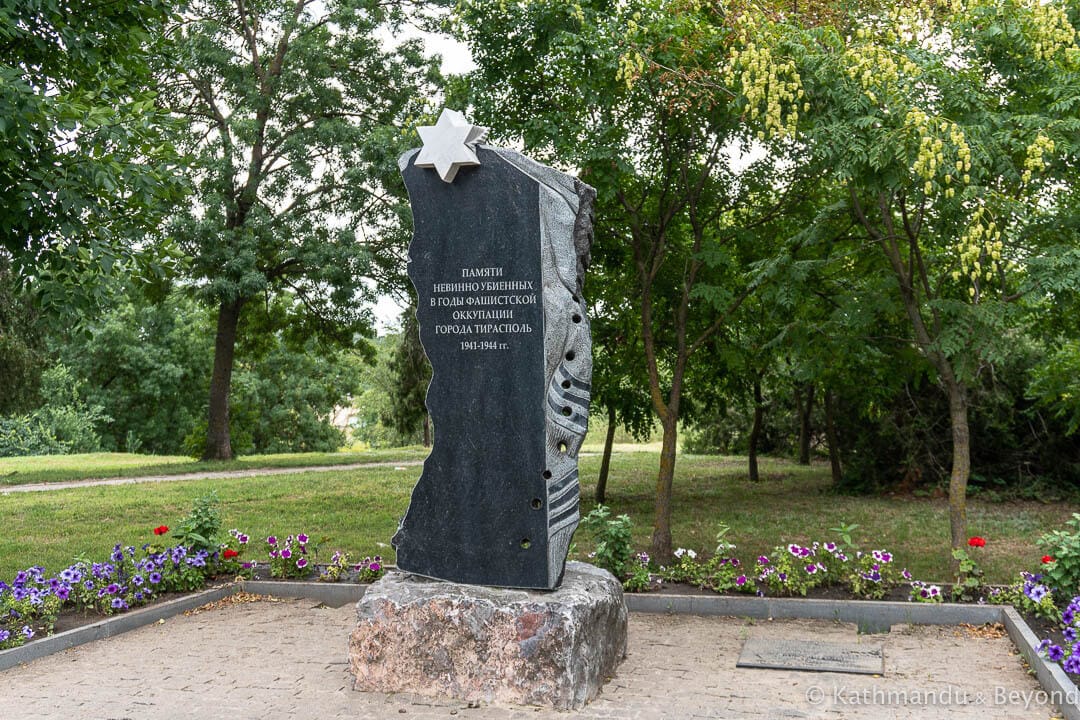
Tiraspol: Monument to the First Moldovan Power Plant (left) and Monument to those killed during the Fascist Occupation (right)
From the bus stop close to the Liberators monument, bus numbers 19 and 19a travel the 8.5kms to Bendery. If you are doing OK with your time (see next paragraph), it is worth getting off the bus along the route to see a superb mosaic on the sidewall of the State Farm named after M.V. Frunze and the Monument to the 40th Anniversary of the Victory over Nazi Germany (Tiraspol Awards Monument). Both are marked on the map and fairly close to one another. We skipped it, but the large “Sheriff” Sports Complex is 500 metres further along the road if you want to see that as well.
Keeping in mind your 10-hour visa restriction, you’ll need at least 2½ hours in Bendery to see all of the locations on our list. Adding in another hour would make it less of a route-march and don’t forget to allow enough time to get to the checkpoint and back into Moldova before your visa expires.
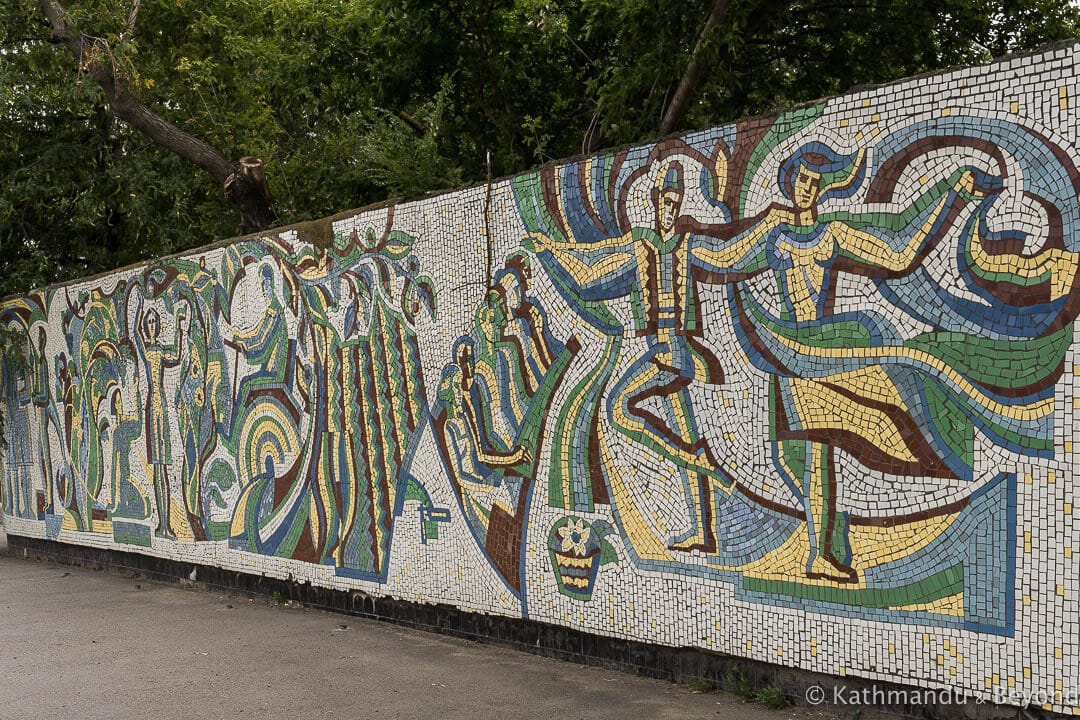
State Farm named after M.V. Frunze, en route between Tiraspol and Bendery
The bus from Tiraspol doesn’t go into Bendery Bus Station. Instead, it drops you off just outside, but it is definitely worth going in and seeing the building’s very #accidentallywesanderson interior. There are three stunning mosaics on the walls, of which the two at either end are titled “Old Bendery” and “New Bendery”. If you are following our route to the letter, like us, you probably won’t have time to hang out at the Soviet-themed CCCP canteen, which is on the first floor of Bendery’s bus station. The idea of a deliberate retro cafe inside a genuinely retro bus station was an odd concept for us to get our heads around!
Update: At some point in 2021, the bus station in Bendery underwent renovations and now has a distinctly not-so-retro feel. Thankfully the mosaic remains intact but the cool green has been white-washed and there is now a clothing outlet in the space beneath it.
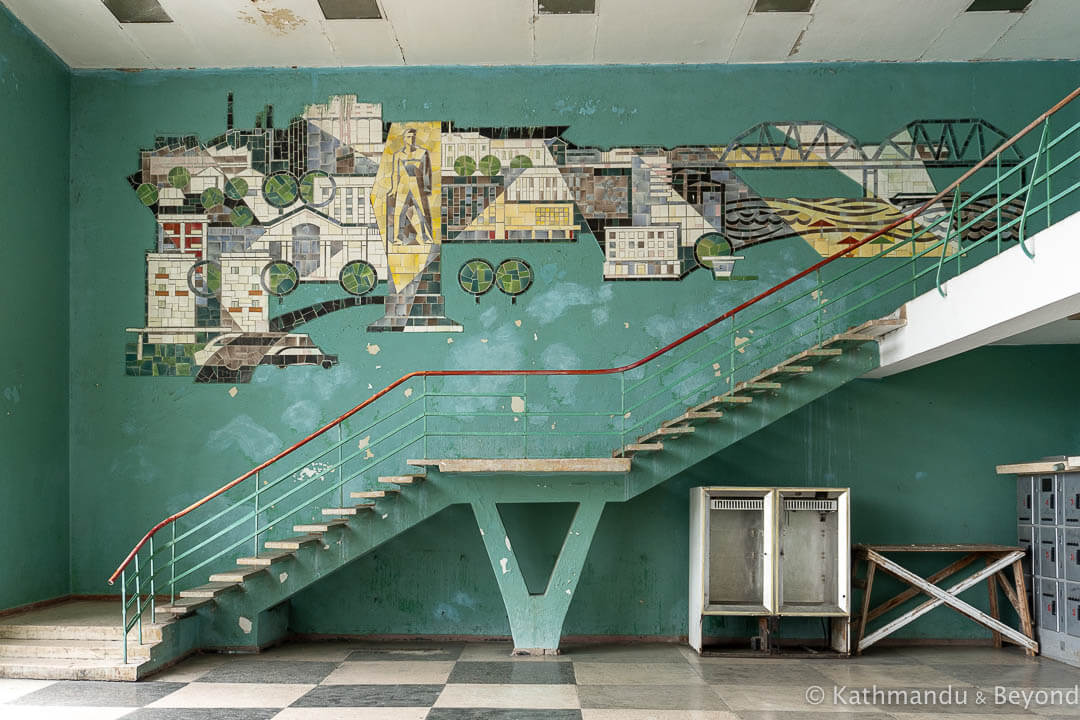
Bendery Bus Station
Heading outside the bus station perimeter, the first things to check out is the stylish Police Booth in the middle of the roundabout and then the series of memorials that commemorate the Transnistria War (2 March to 21 July 1992). Bendery saw some of the worst fighting of the war and there are a few monuments to see in this memorial complex. If you want to visit Bendery/Tighina Fortress, this is the logical point from which to do so. Out of curiosity, we went to have a look but it wasn’t really what we had come to Pridnestrovie (Transnistria) to see and so we didn’t hang around for long before retracing our steps and then heading down to the park near the river. Inside the park, there is a Soviet-era amusement park which we think was still operational although it was pretty hard to tell. Continuing in the park in a southerly direction, the next thing of interest is the Monument to the Fighters for State Soviet Power (also called the Monument commemorating the 50-year anniversary of the Bender Uprising) and, just over the road, is the city’s Soviet-style Wedding Palace.
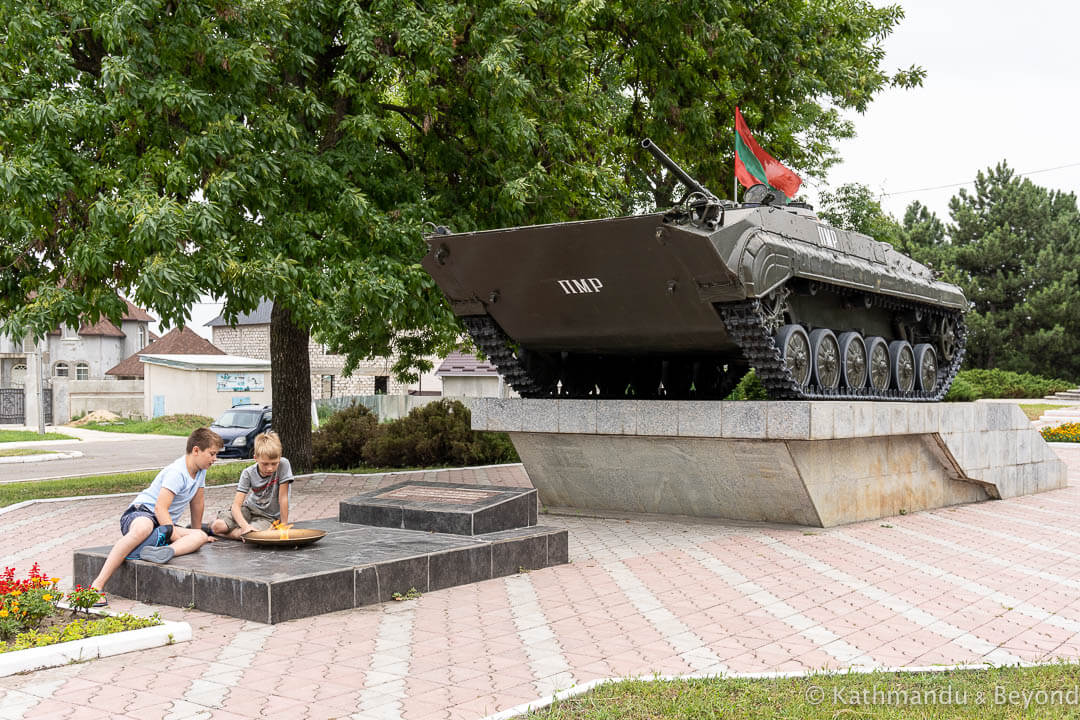
Memorial Park, Bendery
The final thing to see in the park is the Memorial to the Victims of the Holocaust and from there it is a short walk to the mosaic-decorated House of Culture and the socialist realism style Monument to Pavel Tkachenko, the Russian-born Romanian communist activist. You are now on Lenin Street and this will take you through the centre of town to a park and the first of two Lenin monuments that we located in the city. This one is rather mouldy in appearance and, in summer anyway, blends in nicely with its surroundings. There is another ornate mosaic over the road from Lenin, near the Gorky Cinema entitled “Făt-Frumos”. Akin to Prince Charming, Făt-Frumos was a knight-hero in Romanian folklore and the mosaic depicts a scene from one of the fairytales associated with him. It is a nice piece that is worth checking out before heading to the second Lenin, which is in a less prominent position, and therefore trickier to find than the first one.
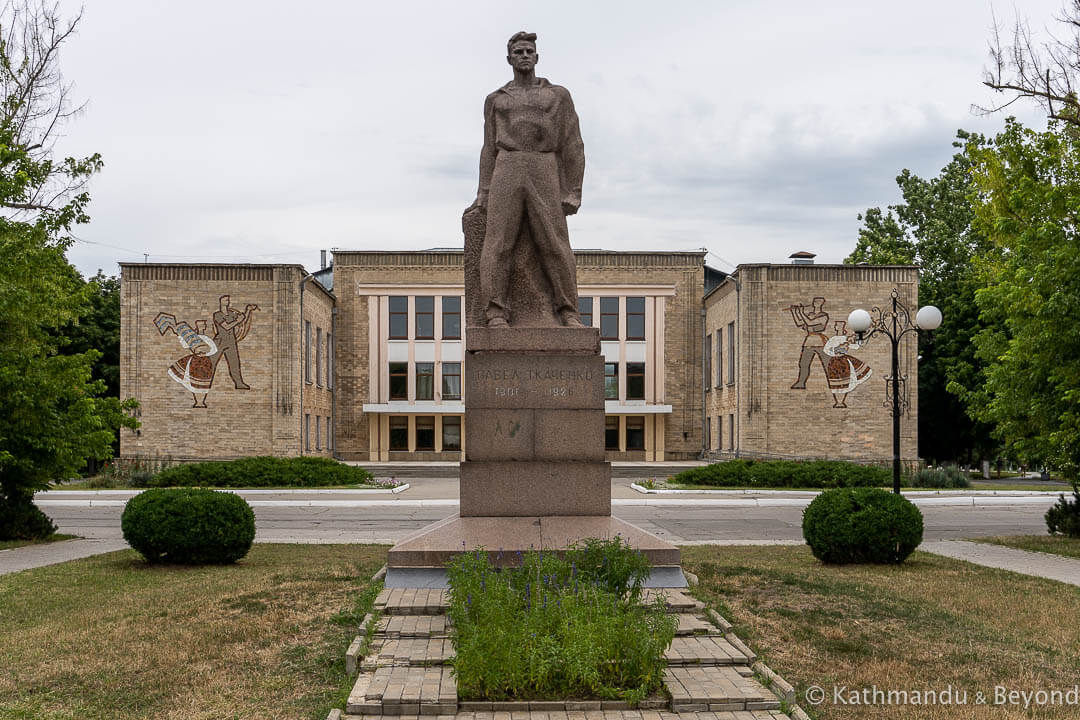
Monument to Pavel Tkachenko and the House of Culture, Bendery
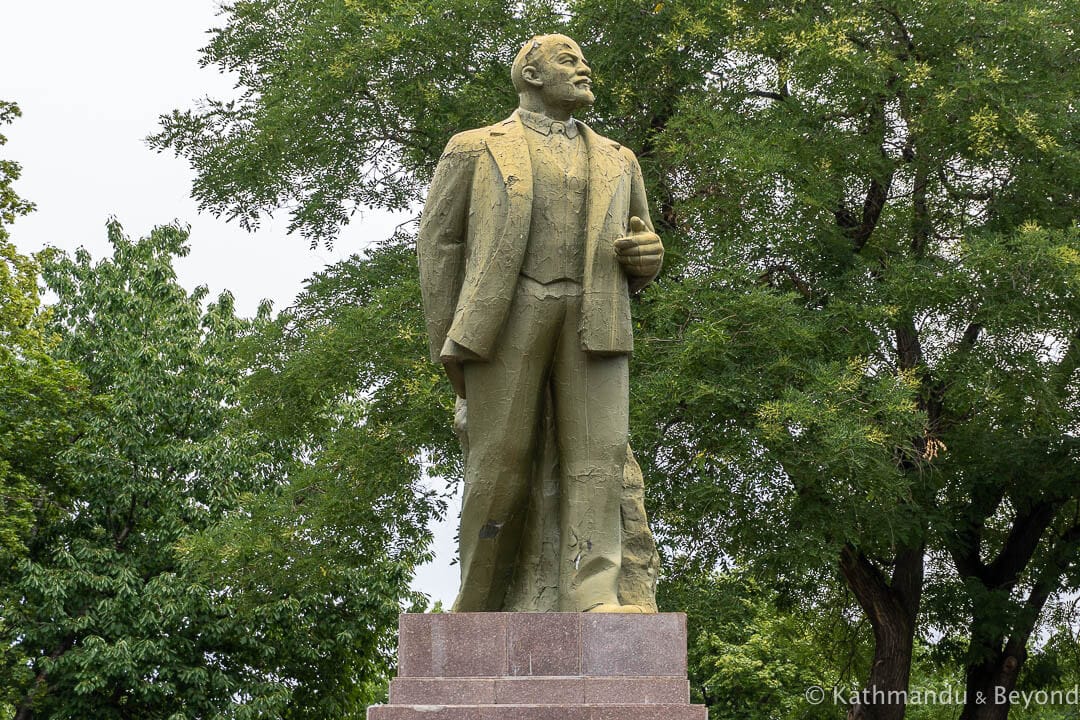
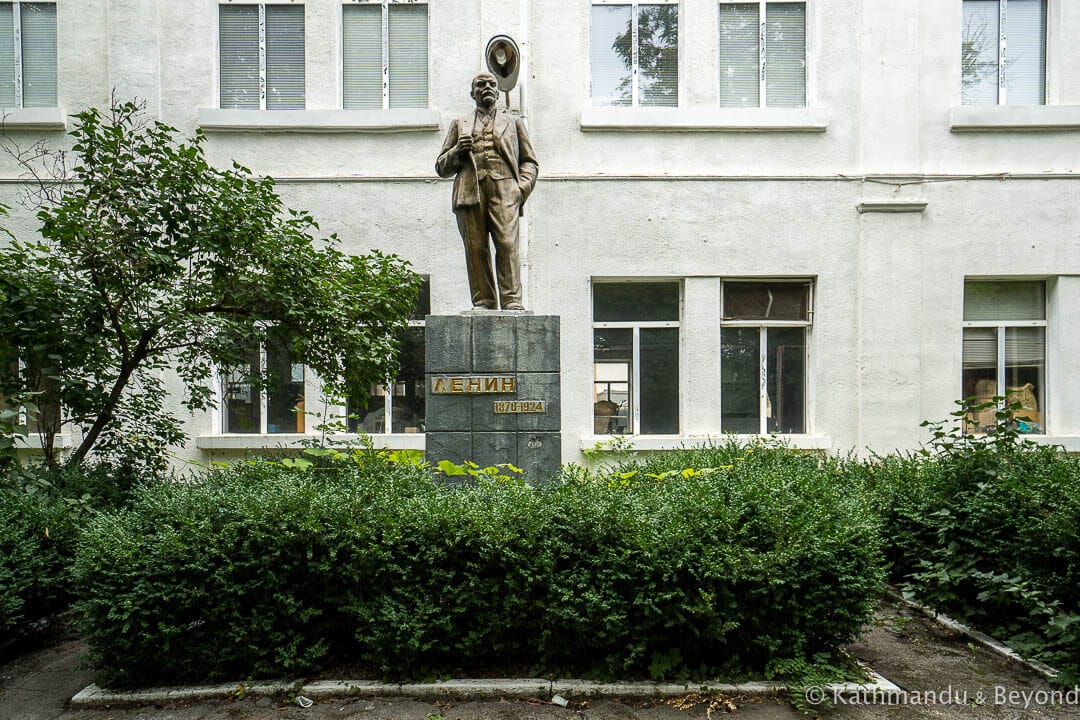
Monuments dedicated to Vladimir Lenin, Bendery
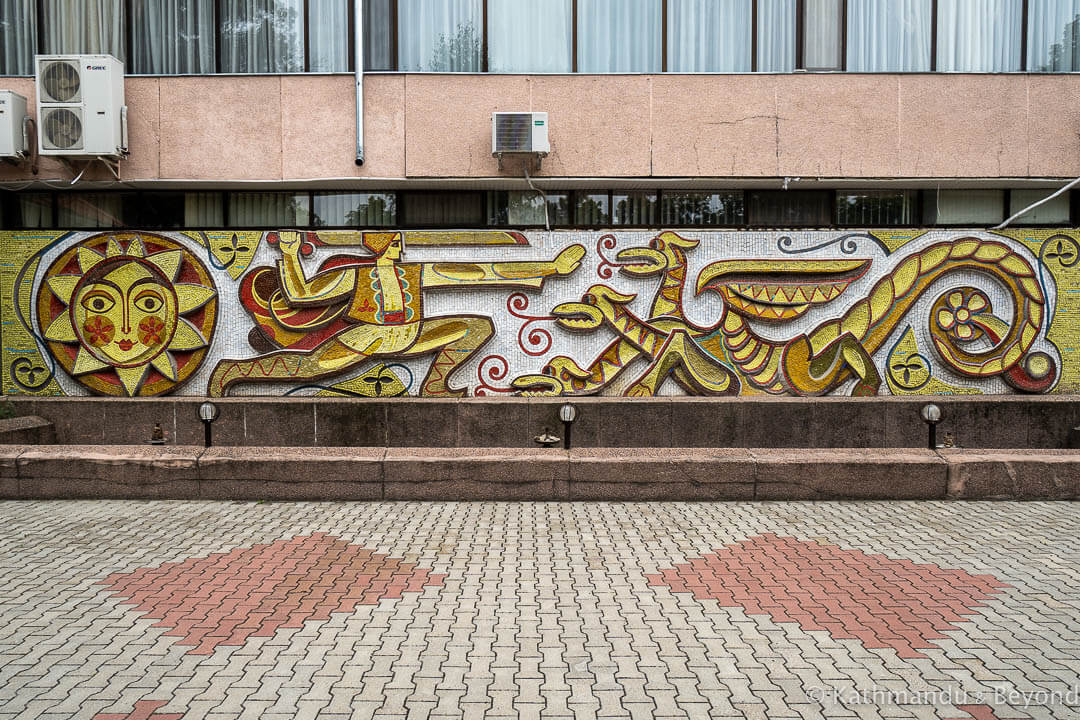
Mosaic entitled “Făt-Frumos”, Bendery
From this point, you can go take a look at the Central Library of Bender, which is a fine example of Soviet modernism before making your way to Bender-1 Railway Station. If you into Stalinist Empire style architecture then you will get a kick out of this train station and there are also some motifs inside it as well. But, the main reason to come here is to see the Memorial to the Revolutionary, Military and Labour Glory of Railway Workers, which comprises the Monument to the Railway Workers, Memorial “Black Fence” and the Museum Complex of the Glory of Railway Workers. The museum is located in a couple of railway carriages that are attached to a fine-looking locomotive with a large Red Star on the front of it. It is run by a handful of very pleasant elderly ladies who do not speak a word of English between them. They will invite you into the museum, which is free (they go to great pains to point this out), and then proceed to tell you all sorts of, no doubt, interesting facts about the exhibits on display even though it is obvious that you don’t speak a word of Russian!
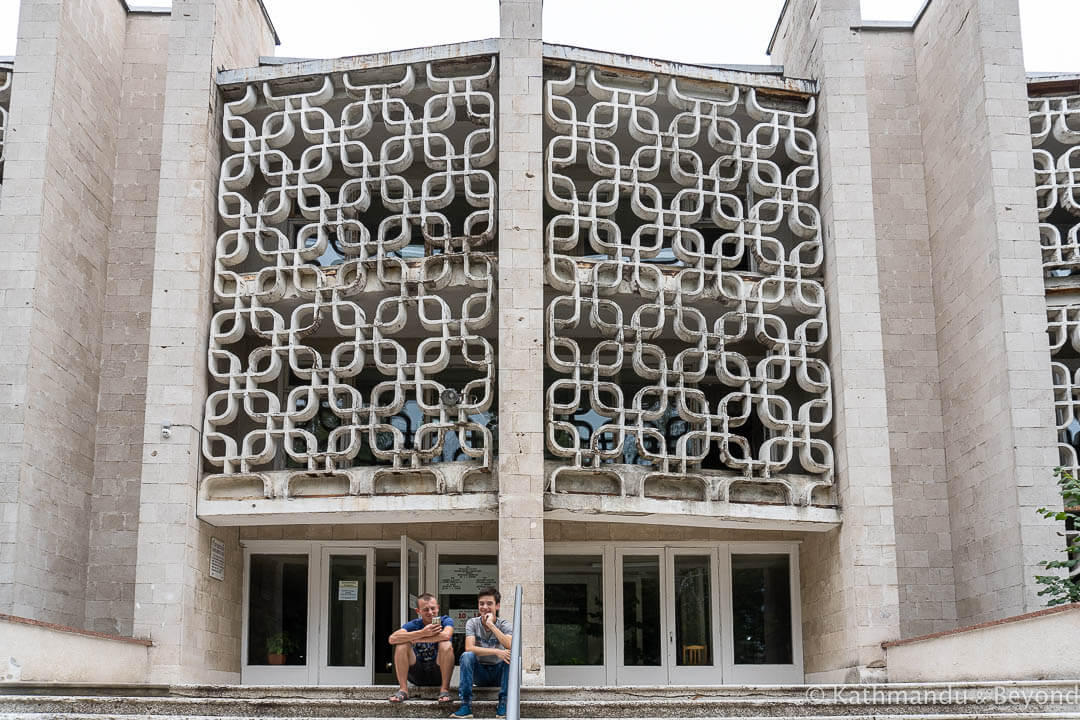
Central Library of Bender
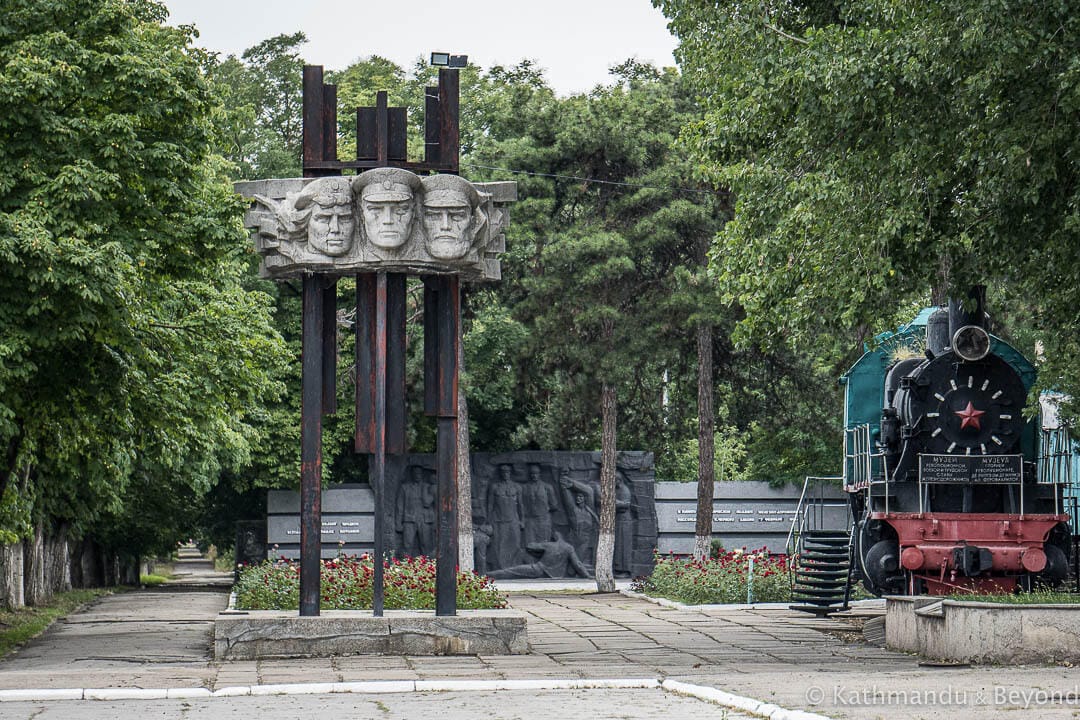
Memorial to the Revolutionary, Military and Labour Glory of Railway Workers: Monument to the Railway Workers (left), Memorial “Black Fence” (centre) and the Museum Complex of the Glory of Railway Workers (right)
From this point, it is a 15-minute (1.4km) walk back to the bus station.
And that’s our suggested route for how best to utilise a 10-hour visa in Pridnestrovie’s (Transnistria) two largest cities.
If you do the entire thing, you’ll cover a lot of miles on foot (we estimated we walked approximately 22kms that day). The only issue we had all day was getting on a marshrutka back from Bendery to Chisinau. I don’t know if it was bad luck or even the time of day (around 6pm), but the reasonably-regular marshrutkas that were coming through from Tiraspol en route to Chisinau were all full and we had to keep waiting for the next one. We had left just over an hour to cover the 9km to the checkpoint/border and with the help of a Moldovan guy, who spoke English and also understood our predicament, we managed to get on one and get back into Moldova proper about 15 minutes before our visa expired. Heather and Kami, mentioned above, also did the same journey and didn’t say anything when we asked them if they had had any transport issues so I suspect we just got caught up in a bit of a rush hour. Indeed, at 3pm when we made preliminary enquiries about getting back to Chisinau at the bus station in Bendery, nobody was waiting in line to buy a ticket.
I’m not sure what the consequences are for overstaying your visa. Our backup plan was to take a taxi to the checkpoint, walk to the other side of it and then try and find onward transport to Chisinau.
If the above concerns you, consider following the suggested route in reverse, hence getting on the return marshrutka at its point of origin in Tiraspol. All marshrutkas travelling between Chisinau and Tiraspol make a stop in Bendery en route so it is easily done.
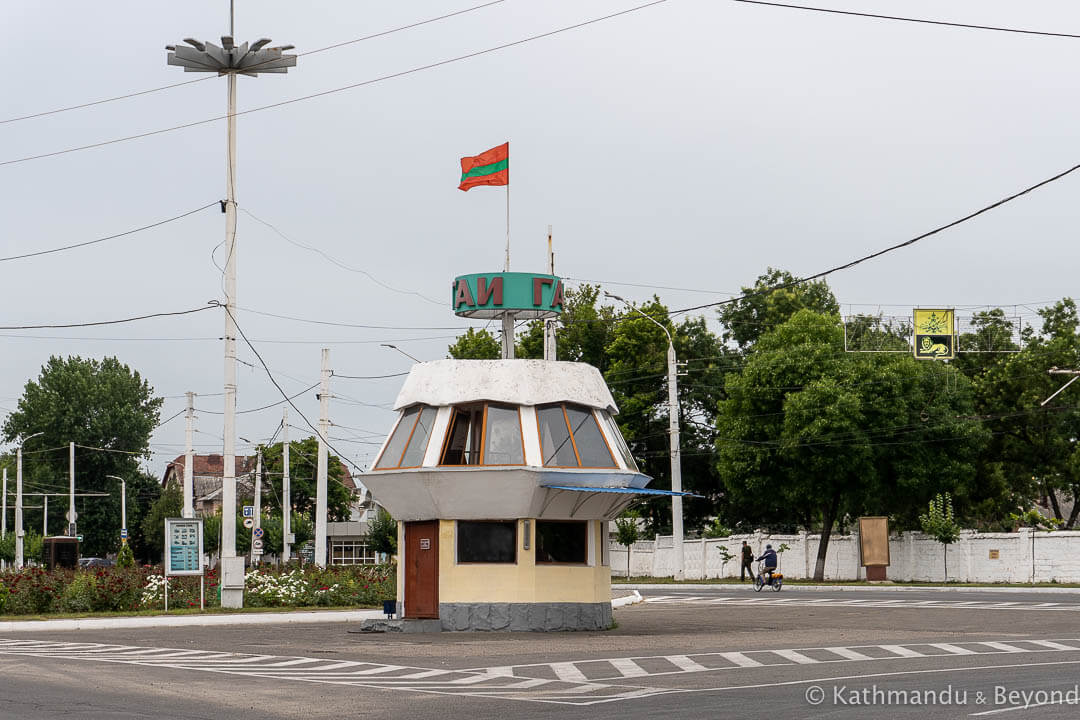
Police Booth, Bendery
Additional tips for visiting Pridnestrovie (Transnistria)
Transport
In Chisinau, marshrutkas depart from the central bus station, which is just behind the main market. Head through the terminal building, turn right and walk to the end bay. The marshrutka will have a sign on the windscreen saying Bendery and Tiraspol in English (and/or Бендеры and Тирасполь respectively in Russian). You will need to buy a ticket from the nearby ticket booth before boarding. Both the staff in the ticket booth and the marshrutka drivers on this route speak a little English and are used to transporting foreigners.
Schedules for the marshrutkas from Chisinau to Tiraspol can be found here. Departures are frequent (around every 15 to 20 minutes) until about 6pm.
Marshrutkas depart from outside the railway station in Tiraspol and will arrive at Bendery’s bus station about 20 minutes later.
Schedules for the marshrutkas from Tiraspol to Chisinau can be found here (the timings are a bit more fluid, but basically you should be able to get transport up until 6.30pm).
The App (iOS and Android) from the brilliant public transport site Eway works in Pridnestrovie (Transnistria) (Tiraspol and Bendery). Local buses are very cheap and a single ride costs three rubles.
Money
It is very easy to get Transnistrian Rubles once you are there. Every other shop in both Tiraspol and Bendery seems to be an exchange place plus, locals will probably exchange with you given half the chance (we bought some Transnistrian Rubles from a lady in the market, for example, and the rate was slightly better). You can exchange Euros, US dollars, Moldovan Leu, Ukrainian Hryvnia and Russian Rubles. Given how easy it is, it makes sense to only exchange a small amount at a time and then get more if you need to. Remember to get rid of any excess Transnistrian Rubles before you leave as you won’t be able to exchange them anywhere else.
You won’t be able to use your credit card, or the ATMs in Pridnestrovie (Transnistria) because the Transnistrian Ruble isn’t recognised in the international banking world. There is reportedly an international ATM on 25 October Street that dispenses US dollars and Russian rubles but it shouldn’t be relied on.
We are not sure about ticket purchase in Tiraspol but, at the bus station in Bendery, you can pay for your marshrutka ticket to Chisinau in Moldovan Leu.
Mobile Phone Coverage
We had a Moldovan Moldcell SIM card and it worked throughout our time in Pridnestrovie (Transnistria).
Pridnestrovie (Transnistria) Visa, Documents and Formalities
On the Chisinau to Tiraspol route, there are no longer any bribery or corruption issues at the checkpoint/border from the Transnistrian guards. The visa is free. When you arrive at the Pridnestrovie (Transnistria) checkpoint (there isn’t really one on the Moldovan side, just a cursory glance at the vehicle), you will be told by the marshrutka driver to enter a small booth. You will be asked (usually in English) your purpose for visiting Pridnestrovie (Transnistria) (say “tourist”) and hand over your passport. This will be returned a few moments later along with a printed slip of paper that clearly states the time of expiry, which is exactly 10 hours from when you handed your passport over. Don’t lose this piece of paper as you will need to hand it back in when you leave. Assuming you haven’t overstayed your visa, departing Pridnestrovie (Transnistria) is just as simple as arriving. There is no need to get off the marshrutka on the return journey as the border guard gets on to check documents and collect the slip of paper/visa.
There is no longer any need to register your stay in Pridnestrovie (Transnistria).
Remember to carry your passport.
Onward Travel
Using Pridnestrovie (Transnistria) as a transit point for travelling between Moldova and Ukraine (Odessa) is an interesting way to link the two countries. You will need to book accommodation in Tiraspol (or Bendery if you prefer) to get longer than the 10-hour visa and there is a daily bus from Tiraspol to Odessa that departs at 9.30am from outside the railway station. You can buy a ticket the day before from inside the railway station and there is an exchange booth right there if you need to get some Transnistrian Rubles. Check our suggested itinerary for this route for further inspiration.
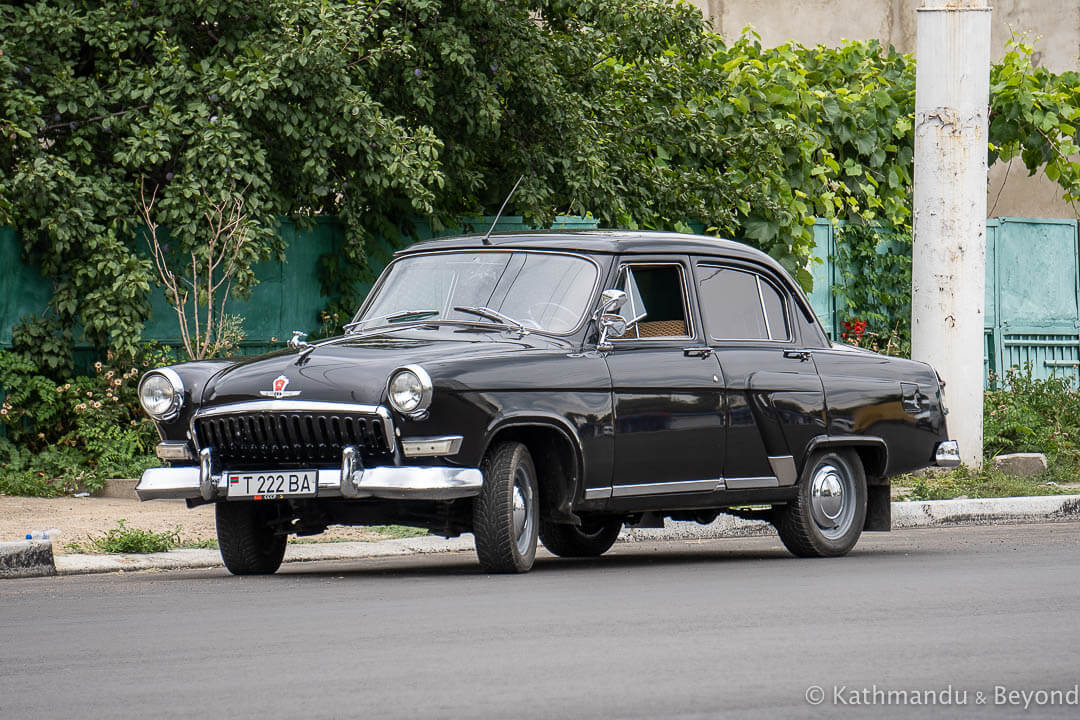
Is Pridnestrovie (Transnistria) safe?
The short answer is yes. However, Pridnestrovie (Transnistria) is not an official country. It is only recognised by three other unrecognised states: Nagorno-Karabakh, Abkhazia and South Ossetia. To the best of our knowledge, the only official country that has an embassy/consulate there is Russia which means that if you get into any trouble it is unlikely you will have any embassy assistance.
What’s more, your travel insurance will probably not be valid for the time you are in Transnistria.
Out and about, we have felt very safe during both of our visits to Pridnestrovie (Transnistria) and the warning above is more related to other kinds of issues. Photographing any military facilities or factories is asking for trouble, for example, as is entering seemingly abandoned buildings. As you can see from our website, we are into exploring abandoned locations but in a place like Pridnestrovie (Transnistria), it’s just not worth the trouble it may cause in my opinion.
Also, keep your passport safe, don’t cross the road unless you are on a crossing or have a green light (*) and watch out for manholes and other potential hazards in order to avoid having any accidents!
(*) You will notice the locals don’t do this either. In a number of post-Soviet countries, Belarus for example, you’ll get in trouble with the authorities if you are caught jaywalking.
All the above might sound a bit mumsy but we had an incident in Abkhazia in 2018 which could have been way worse than it actually was, even though we were robbed by three guys and lost a reasonable amount of money. In relation to Foreign Office Advice and travel insurance, visiting Pridnestrovie (Transnistria) is no different from going to Abkhazia.
Here’s what the British Foreign and Commonwealth Office (FCO) has to say about Pridnestrovie (Transnistria):
“You should exercise caution if you travel to Transnistria and avoid getting into difficulty with the Transnistrian authorities. If you do get into trouble, try to contact the British Embassy in Chisinau at an early stage. The embassy will do its best to provide consular help where needed. But in practice, this will be very limited.”
Source: https://www.gov.uk/foreign-travel-advice/moldova/safety-and-security
Are you planning a visit to Pridnestrovie (Transnistria)? Pin this to your travel boards of countries that don’t exist!
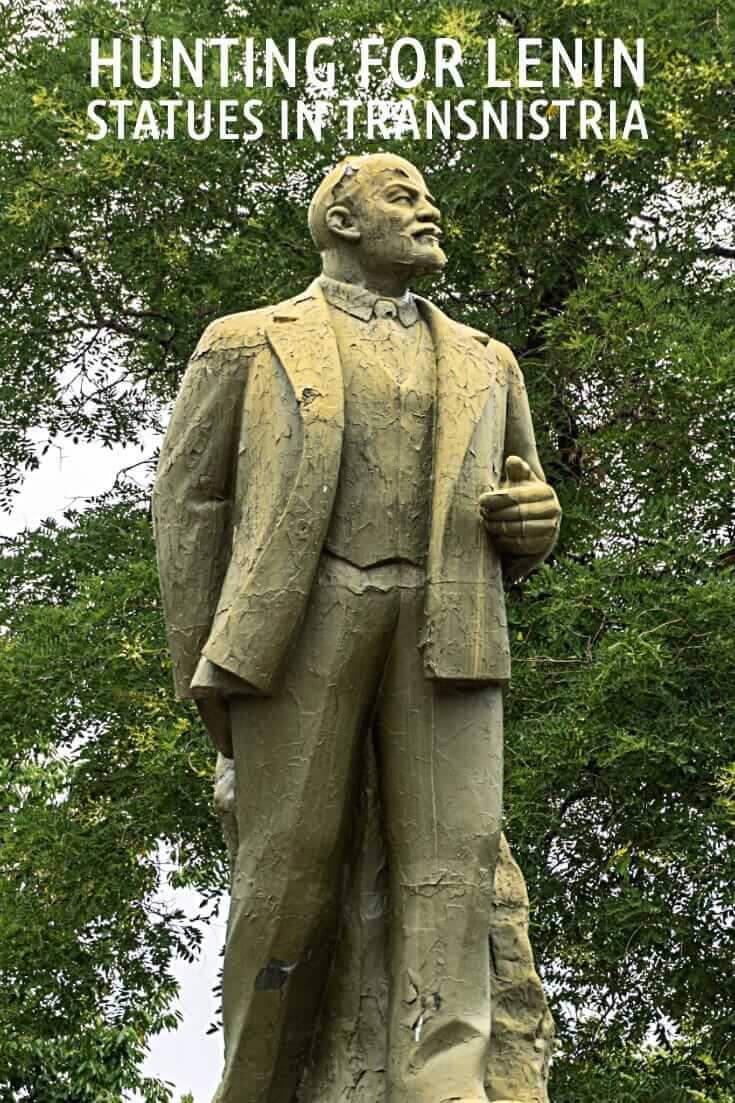
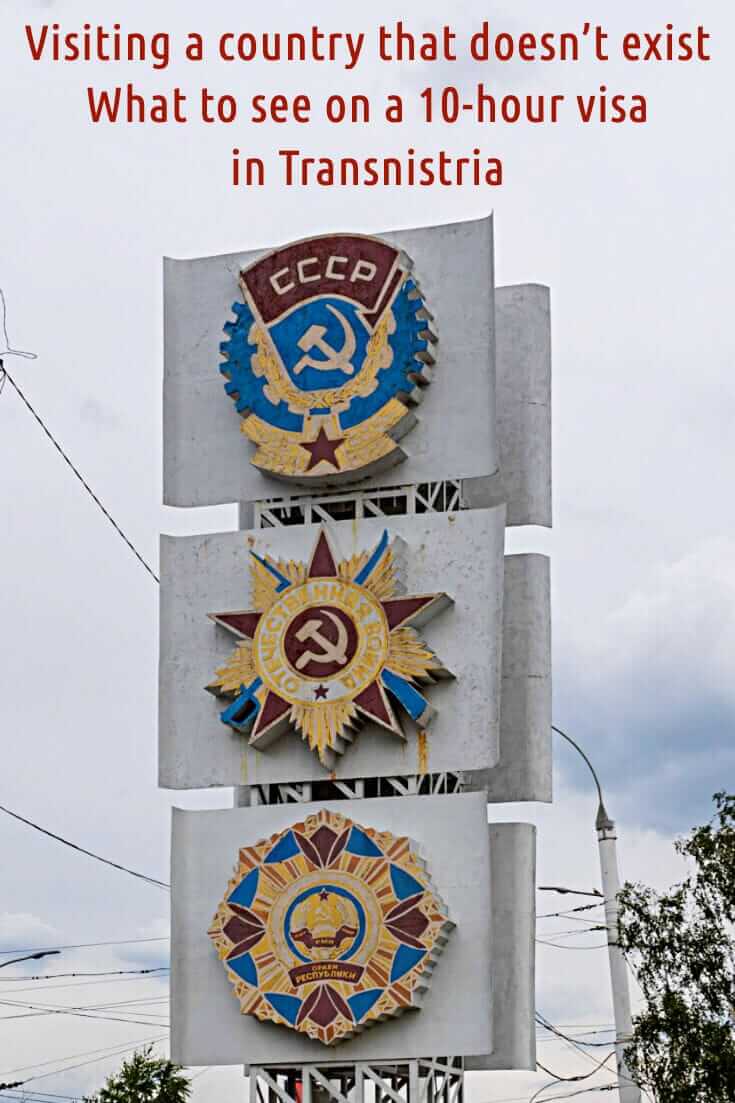
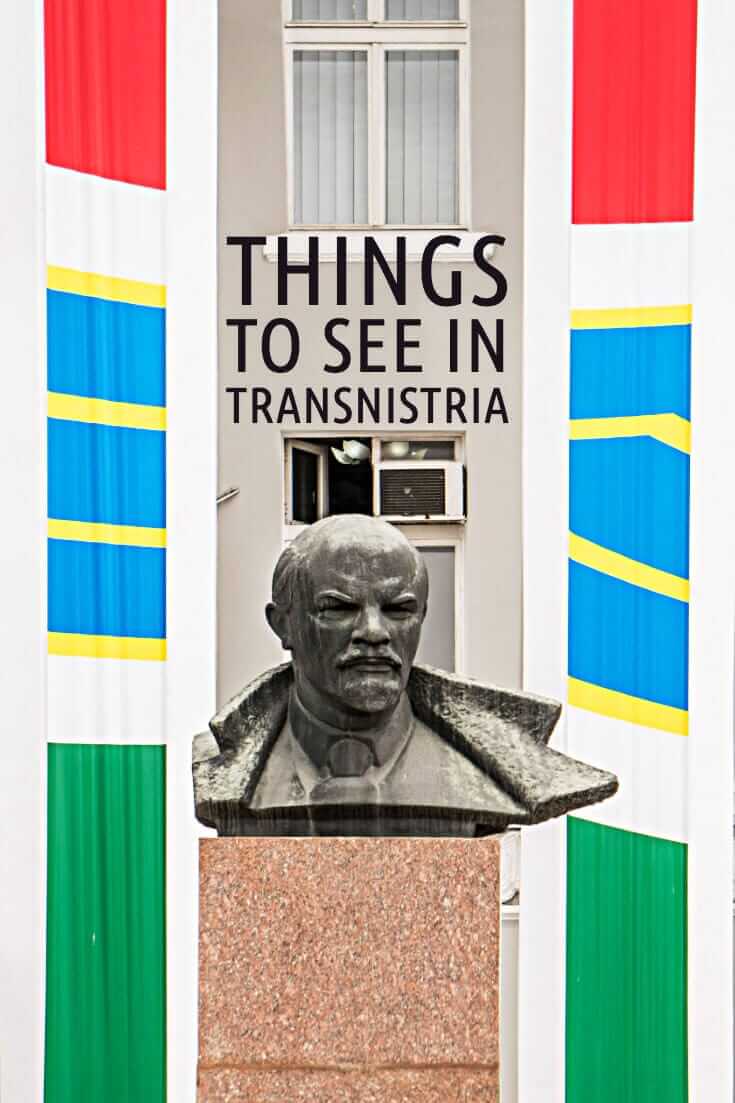

Trackbacks/Pingbacks